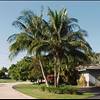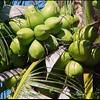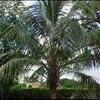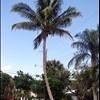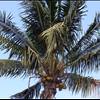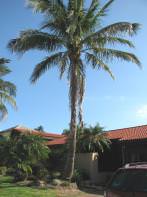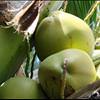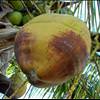This plant may be available to buy
Click the banana to see

|
click pics to enlarge |
|
Zone 10 Nothing could be finer than a coconut palm. No other palm says "tropical" like the coconut and few can be argued as more beautiful. The coconut palm is also the most recognized palm in the world There are several varieties planted but the old 'Jamaica Tall' coconuts have almost all died of Lethal Yellowing disease. This previously dominant variety is the very tall, curving type. We now plant the shorter, fatter Green Malayan Coconut which produces green nuts. We also plant the less popular Golden Malayan which sports yellow nuts and somewhat yellow fronds. There is also a Red Malayan species. These are rated at 95% resistant to Lethal Yellowing The taller growing Maypan Coconut is harder to acquire but reminds us of the stately Jamaicans of the times before Lethal Yellowing took its toll click pics to enlarge This is a cross between the 'Malayan Dwarf' and the 'Panama Tall' cultivars A new type is the 'Red Spicata Dwarf' cultivar. Slower growing than the Maypan, it is actually a semi-dwarf plant, and shorter than "Malayan Dwarf' variety. It has a more delicate appearance and orange-red fruit. It is being tested for disease resistance to Lethal Yellowing Another new coconut is the 'Fiji Dwarf' and is another shorter palm. It has a crown of leaflets that are very wide and produce a dense shade. It is a true dwarf, slow growing and will be relatively small at maturity. We hope it is successful so we can more easily pick the nuts :-) The most rare variety is the Double Coconut, Lodoicoa maldivica, whose fruit size is more like 5x a normal Coconut :-) Coconuts are salt tolerant growing right on the beach, but do better a few hundred feet back For best results, acquire a small young coconut and plant it with plenty of high quality manure (50 lbs. is good) mixed in the planting hole and soil Fertilize 4x to 6x a year with top quality palm food and watch your coconut grow to its maximum beauty. If you plant young trees and care for them well, they get extra fat and grow even more beautiful click pic to enlarge Many think of all coconut palms as growing all over Florida, but the coconut is a tropical which will eventually freeze north of approx. West Palm Beach on the east coast and approx. north of Fort Myers on the west coast of Florida We get email from folks who talk about their coconut palm growing outside those "boundaries" but eventually a freeze will kill. For example, there once were an estimated 25,000 coconut palms growing happily in Vero Beach ...all those "originals" died within 4 hours one freezing night Spouting Palm Seeds Sprouting palms and growing palms from seed, use fresh seeds and follow the advice for coconuts below To start a coconut from the seed, you want a freshly fallen brown-dry (somewhat shrunken) nut with the outer fibrous husk intact
click pics to enlarge Get a 3-gallon pot. Use high quality nursery soil mixed with 40% coarse sand. Add drainage rocks to the bottom of the pot Lay your coconut husk on the ground and see which way it wants to rest. Plant your coconut husk 1/2 way into the soil in the same position You can leave the pot in the sun or the shade. Water lightly to keep very lightly moist. Partial shade will likely be more successful Be patient. The first time we started a coconut from seed it took 9 nine months to sprout. It is common for many palms to take many months to sprout. Don't over water as you'll rot them out A coconut often will first split its husk at the bottom and send down some roots. It may take several months before your coconut also splits the top of the husk pushing up its first fronds. Every one is a little different. Your nut may split the top first After your coconut spouts, your coconut can live in your 3-gallon pot for about 3-6 months. After that, plant it in another larger pot or directly into the soil. Incorporate lots of composted manure mixed into your soil. Fertilize properly starting after sprouting 3 fronds |
